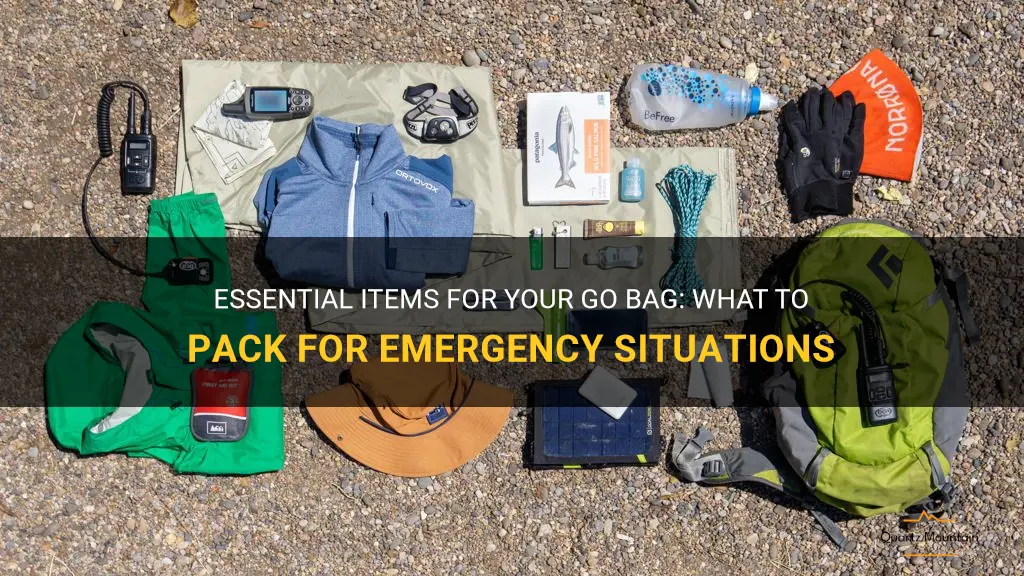
In times of emergency, having a go bag packed and ready to grab can be a lifesaver. Whether you're facing a natural disaster, a power outage, or any other potential crisis, having essential items on hand can ensure your safety and comfort. But what exactly should you pack in your go bag? From survival gear to personal hygiene items, this article will guide you through the essentials you need to include in your go bag for any emergency situation.
| Characteristics | Values |
|---|---|
| Size | Medium |
| Material | Durable |
| Waterproof | Yes |
| Compartments | Multiple |
| Weight | Lightweight |
| Straps | Adjustable |
| Closure | Zipper |
| Pockets | Exterior and Interior |
| Handles | Reinforced |
| Color | Dark-colored |
| Visibility | Reflective |
| Organization | Divider panels |
| Accessibility | Quick-access pockets |
| Lockable | Yes, with a lockable zipper |
| Shoulder strap | Yes, detachable |
| Trolley sleeve | Yes, for easy transport with luggage |
What You'll Learn
- What essential items should be included in a go bag or emergency kit?
- How much food and water should someone pack in their go bag?
- Are there any specific medical supplies or medications that should be included?
- Should important documents and personal identification be included in a go bag?
- How often should someone update and refresh the items in their go bag?

What essential items should be included in a go bag or emergency kit?
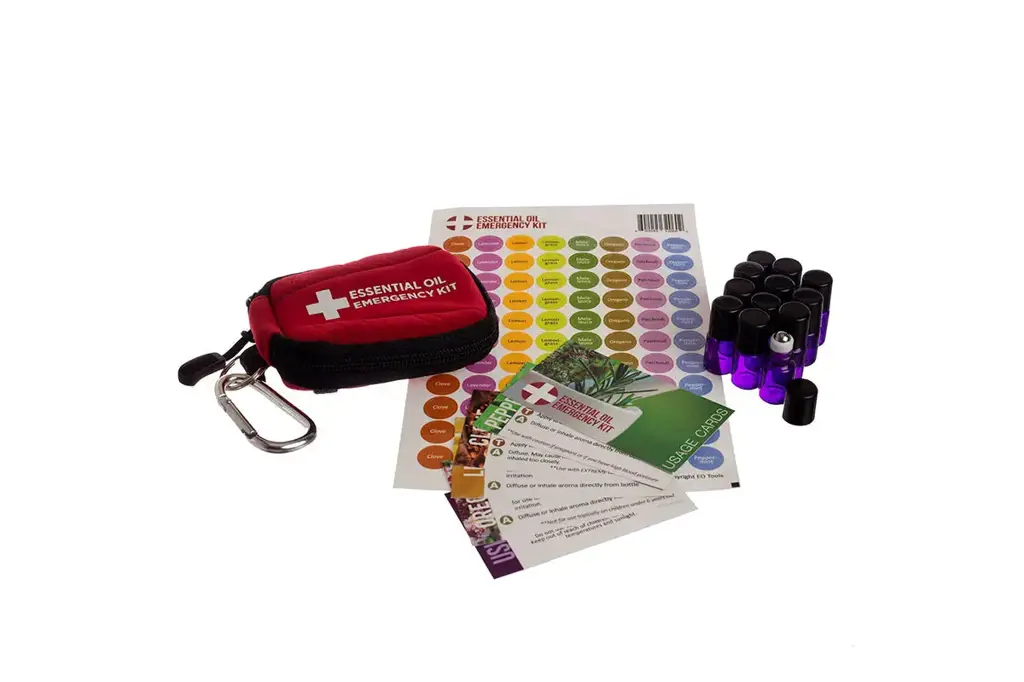
A go bag or emergency kit is a crucial item to have in case of an emergency or evacuation. It should contain essential items that can sustain you and your family for at least 72 hours. Here is a step-by-step guide on what should be included in a go bag or emergency kit.
- Water: Water is the most essential item to include in your go bag. Each person should have at least one gallon of water per day for drinking and sanitation purposes.
- Food: Pack non-perishable food items that can provide sufficient nutrition. Include items such as canned food, energy bars, nuts, and dried fruits. Don't forget to pack a manual can opener.
- First Aid Kit: A comprehensive first aid kit is essential. It should include bandages, gauze pads, adhesive tape, antiseptic wipes, pain relievers, tweezers, scissors, and any specific medications you or your family members may need.
- Prescription Medications: If you or any family member requires prescription medications, ensure you have a sufficient supply in your go bag. Rotate the medications periodically to keep them up to date.
- Clothing and Bedding: Pack a change of clothes for each family member, including warm clothing, socks, sturdy shoes, and a jacket. Don't forget to include extra blankets or sleeping bags for warmth.
- Personal Hygiene Items: Include toiletries such as toothbrushes, toothpaste, soap, hand sanitizer, wet wipes, and menstrual supplies if needed.
- Important Documents: Keep photocopies of important documents such as identification papers, passports, insurance policies, bank account information, and emergency contact numbers in a waterproof bag.
- Cash: Keep a small amount of cash in your go bag in case ATMs are inaccessible during an emergency.
- Flashlight and Batteries: Ensure you have a reliable flashlight and spare batteries. Consider including a headlamp for hands-free use.
- Radio: A battery-powered or hand-cranked radio is crucial for receiving emergency updates and staying informed.
- Whistle: A whistle can help to attract attention if you are in need of help.
- Multi-tool: A multi-tool can be used for various tasks such as cutting, opening cans, and repairing items.
- Extra Phone Charger and Backup Battery: In case of power outages, include an extra phone charger and a portable battery to keep your phone charged for communication.
- Maps: Include a road map of your local area, as well as maps of nearby cities or evacuation routes.
- Pet Supplies: If you have pets, pack food, water, medications, leash, and any other necessary supplies for them.
Remember to periodically check and update your go bag or emergency kit. Ensure that all items are in good condition and that perishable items are replaced regularly. Additionally, educate yourself and your family members on how to use the items in the kit. Having a well-prepared go bag can provide peace of mind and be a lifesaver during times of emergency.
A definitive guide on what to pack for your trip to Malta
You may want to see also

How much food and water should someone pack in their go bag?
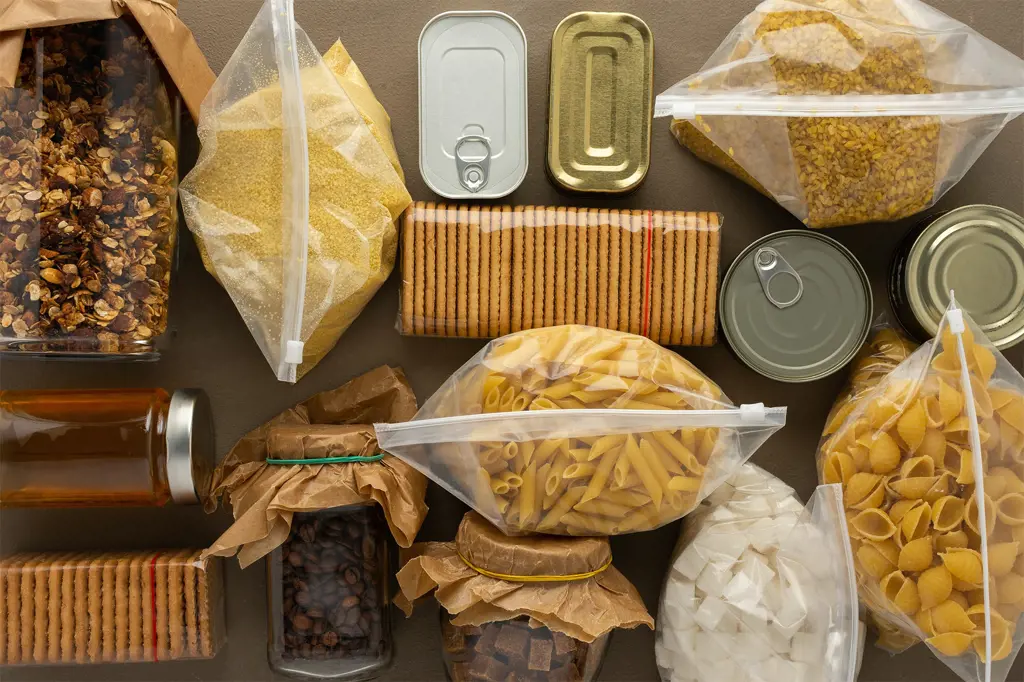
When preparing a go bag, it is important to include enough food and water to sustain yourself in case of an emergency. The amount of food and water you should pack will depend on various factors such as the duration of the emergency, your individual needs, and the available space in your bag. In this article, we will discuss how much food and water you should pack in your go bag based on scientific guidelines, personal experience, step-by-step instructions, and examples.
Scientific guidelines recommend that an individual should consume at least 2 liters (or about half a gallon) of water per day to maintain hydration. Therefore, it is recommended to pack at least 3-4 liters (or 1-1.5 gallons) of water per person per day in your go bag. This will provide enough water for drinking, cooking, and basic hygiene needs.
When it comes to food, it is important to choose non-perishable, high-calorie options that require little to no preparation. Examples of such foods include energy bars, nuts and seeds, dried fruits, canned goods, and ready-to-eat meals. The general rule of thumb is to pack enough food to provide 2,000-2,500 calories per day, which is the average daily caloric intake for an adult. However, this amount may vary depending on your individual needs and energy expenditure.
In terms of quantity, a good starting point is to pack at least three days' worth of food and water in your go bag. This will provide enough sustenance until additional supplies can be secured. However, it is recommended to pack extra food and water if you have the space and resources, especially in case of longer-lasting emergency situations or if you are responsible for the needs of multiple people.
Here is a step-by-step guide to help you determine how much food and water you should pack in your go bag:
- Assess the duration of the emergency: Consider how long you anticipate being away from a reliable water and food source. This will give you an idea of how much water and food you need to pack.
- Calculate your water needs: Multiply the number of people in your group by the recommended 3-4 liters per person per day. This will give you the total amount of water you need for one day. Multiply this by the number of days you anticipate being away to determine the total amount of water to pack.
- Choose high-calorie, non-perishable food options: Select food items that are lightweight, compact, and rich in calories. Aim for 2,000-2,500 calories per day and pack enough food for the number of days you anticipate being away.
- Consider dietary restrictions and preferences: If you or someone in your group has specific dietary needs or restrictions, make sure to pack food options that cater to those requirements. This may include gluten-free, vegetarian, or vegan options.
- Pack extra supplies if possible: If you have the space and resources, consider packing extra food and water to account for unforeseen circumstances or longer-lasting emergencies.
To put this into perspective, let's consider an example: If you are preparing a go bag for a three-day emergency and you have two people in your household, you would need to pack at least 18-24 liters (or 4.5-6 gallons) of water and enough food to provide 12,000-15,000 calories for three days.
In conclusion, when packing a go bag, it is important to include enough food and water to sustain yourself during an emergency. Scientific guidelines recommend at least 2 liters of water per person per day and 2,000-2,500 calories per day. However, these amounts may vary depending on individual needs, the duration of the emergency, and available resources. By following the step-by-step guide and considering examples, you can determine how much food and water you should pack in your go bag to be adequately prepared.
The Essential Packing Guide for a Trip to the Picturesque Lake District in August
You may want to see also

Are there any specific medical supplies or medications that should be included?
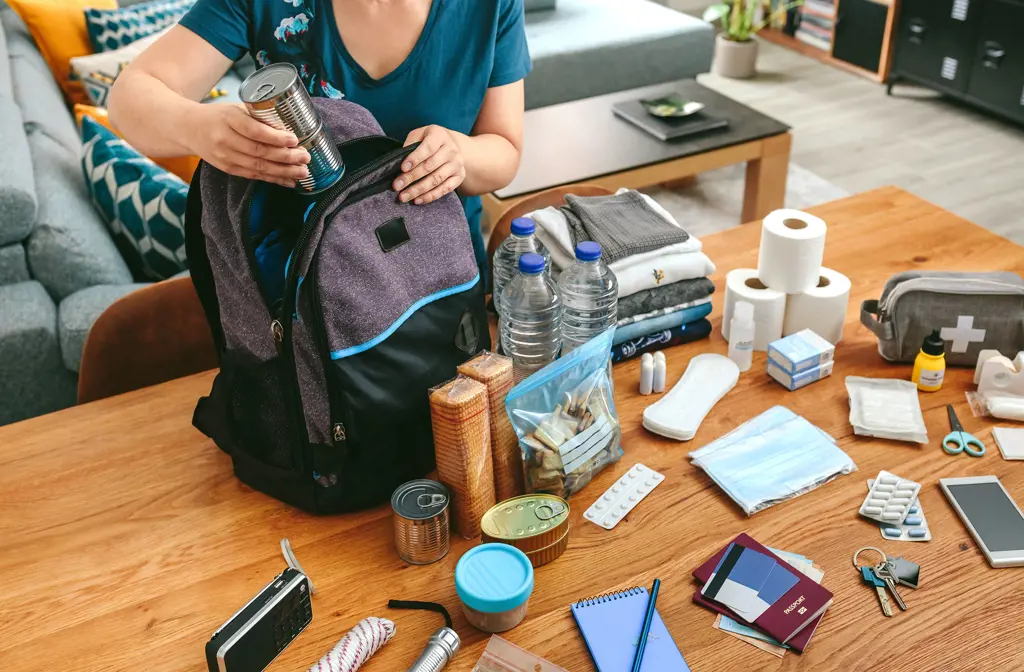
When it comes to creating a medical emergency kit, there are several important factors to consider. One crucial aspect is determining which medical supplies and medications should be included. Having the right items on hand can make a significant difference in the outcome of an emergency situation. Here are some specific medical supplies and medications that should be included in a well-stocked emergency kit.
- Bandages and dressings: It is essential to have a variety of bandages and dressings to treat different types of wounds. These can include adhesive bandages, sterile gauze pads, adhesive tape, and elastic bandages for sprains or strains. It is advisable to have different sizes of bandages to cater to various injuries.
- Antiseptics: Infections are a common concern in emergency situations. Including antiseptic solutions like hydrogen peroxide or iodine can help clean wounds and prevent bacterial growth. Disinfectant wipes or swabs are also useful for cleaning the skin before surgery or injections.
- Over-the-counter pain relievers: Pain can be a common symptom in emergencies. Including medications like ibuprofen or acetaminophen can provide relief to individuals in pain. These medications can help manage pain resulting from injuries, headaches, or muscle aches.
- Antibiotics and antiviral medications: In certain situations, it may be necessary to have antibiotics or antiviral medications on hand. These can be used to treat bacterial or viral infections that may arise during an emergency. However, it is important to consult a healthcare professional for guidance on specific medications and dosages.
- Medical equipment: In addition to medications and supplies, having essential medical equipment is crucial in an emergency situation. Some key items to include are a thermometer, blood pressure cuff, stethoscope, and a basic first aid manual. These tools can help measure vital signs and provide valuable information to healthcare professionals.
- Prescription medications: If someone in your household requires daily prescription medications, it is vital to have a sufficient supply in your emergency kit. These medications should be regularly rotated to ensure they do not expire. It is also important to include any necessary medical devices such as insulin syringes or inhalers.
- Personal protective equipment (PPE): In light of the COVID-19 pandemic, it is essential to include personal protective equipment in your emergency kit. This can include items such as gloves, masks, and hand sanitizers to protect against infectious diseases.
It is important to regularly check the expiration dates of medications and supplies and replace them as needed. Additionally, remember to store the emergency kit in a cool, dry place, away from children and pets.
While these are some general recommendations, it is crucial to consult with a healthcare professional to tailor your emergency kit to specific medical conditions or health concerns. They can provide guidance on any additional items that may be necessary based on individual needs.
In conclusion, including the right medical supplies and medications in an emergency kit can greatly improve the ability to respond effectively to unexpected situations. It is important to have a wide range of supplies, from bandages and antiseptics to pain relievers and prescription medications. By being well-prepared, you can ensure that you are equipped to handle a medical emergency with the necessary resources.
Essential Items to Pack for Your Cotopaxi Adventure
You may want to see also

Should important documents and personal identification be included in a go bag?
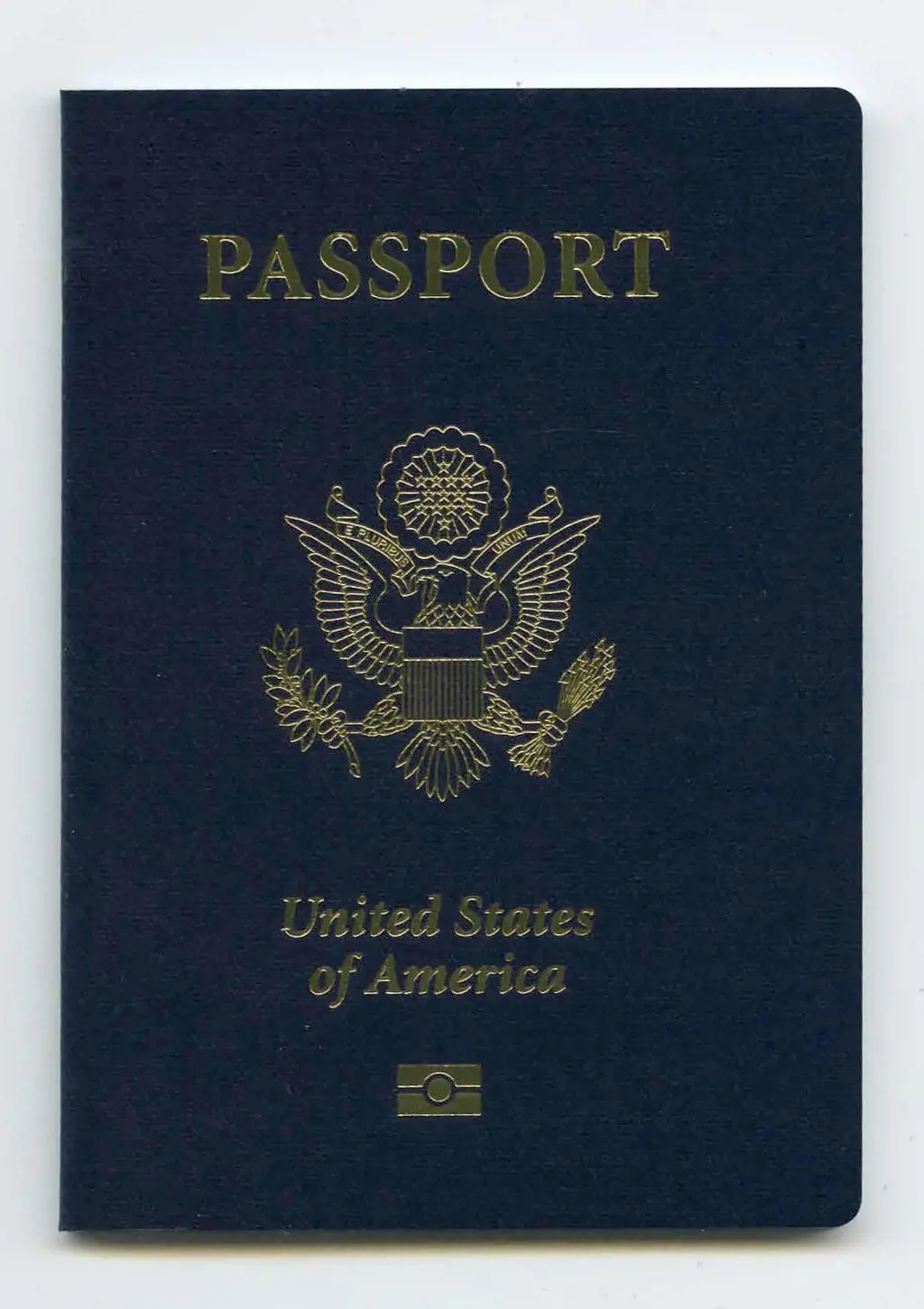
In the event of an emergency, having a go bag prepared can be a life-saving measure. A go bag is a pre-packed bag filled with essential items that can sustain you for at least 72 hours when disaster strikes. While many people focus on packing food, water, and other survival essentials, the question arises: should important documents and personal identification be included in a go bag?
The answer is a resounding yes. Including important documents and personal identification in a go bag is crucial for several reasons. Let's explore why this is important.
First and foremost, having your important documents readily available can help alleviate stress and confusion during an emergency. When disaster strikes, you may be forced to evacuate your home and leave everything behind. In such moments, having your documents in your go bag can provide a sense of security and peace of mind.
Furthermore, important documents and personal identification can be vital in situations where you need to prove your identity or access important information. For example, if you are evacuated to a shelter, having your identification can facilitate the registration process and enable authorities to contact your loved ones or provide necessary assistance. Similarly, having important documents such as medical records, insurance information, and contact lists can help healthcare providers understand your medical history and provide appropriate care.
Additionally, including important documents and personal identification in a go bag ensures that they remain safe and protected during an emergency. Disasters such as floods, fires, or earthquakes can cause damage to your home and destroy valuable documents. By keeping them in a go bag, you can ensure that they are readily accessible and protected from damage.
When it comes to packing important documents and personal identification in a go bag, it is essential to choose appropriate storage methods. Here are some step-by-step guidelines to ensure their safety and accessibility:
- Gather all necessary documents: Start by gathering important documents such as passports, driver's licenses, birth certificates, social security cards, medical records, and any legal documents (such as wills or power of attorney). Also include a list of emergency contacts and relevant insurance information.
- Organize and protect: Place the documents in a waterproof and fireproof container or a sealed plastic bag to protect them from potential damage. It is advisable to use separate sleeves or folders to keep them organized and prevent them from getting lost or mixed up.
- Make copies: Create multiple copies of each document and store them separately. Keep a set in your go bag and distribute others to trusted family members or store them in a secure location, such as a safe deposit box.
- Update regularly: Periodically review and update the documents in your go bag to ensure they remain current. Pay attention to expiration dates on identification documents and update them as necessary.
Finally, it is worth mentioning some real-life examples where having important documents and personal identification in a go bag proved invaluable. During natural disasters like hurricanes, tornadoes, or floods, individuals who had their vital documents readily available were able to quickly access emergency funds, insurance benefits, and temporary housing assistance. In times of national emergencies or political instability, having identification documents can help facilitate evacuation or secure travel permits.
In conclusion, including important documents and personal identification in a go bag is a vital step in emergency preparedness. It not only provides a sense of security but also facilitates your access to essential services and support during and after a disaster. By following the steps outlined above, you can ensure that your important documents are protected, organized, and readily available when you need them the most.
The Essential Packing Guide for a Memorable Carnival Cruise to Mexico
You may want to see also

How often should someone update and refresh the items in their go bag?
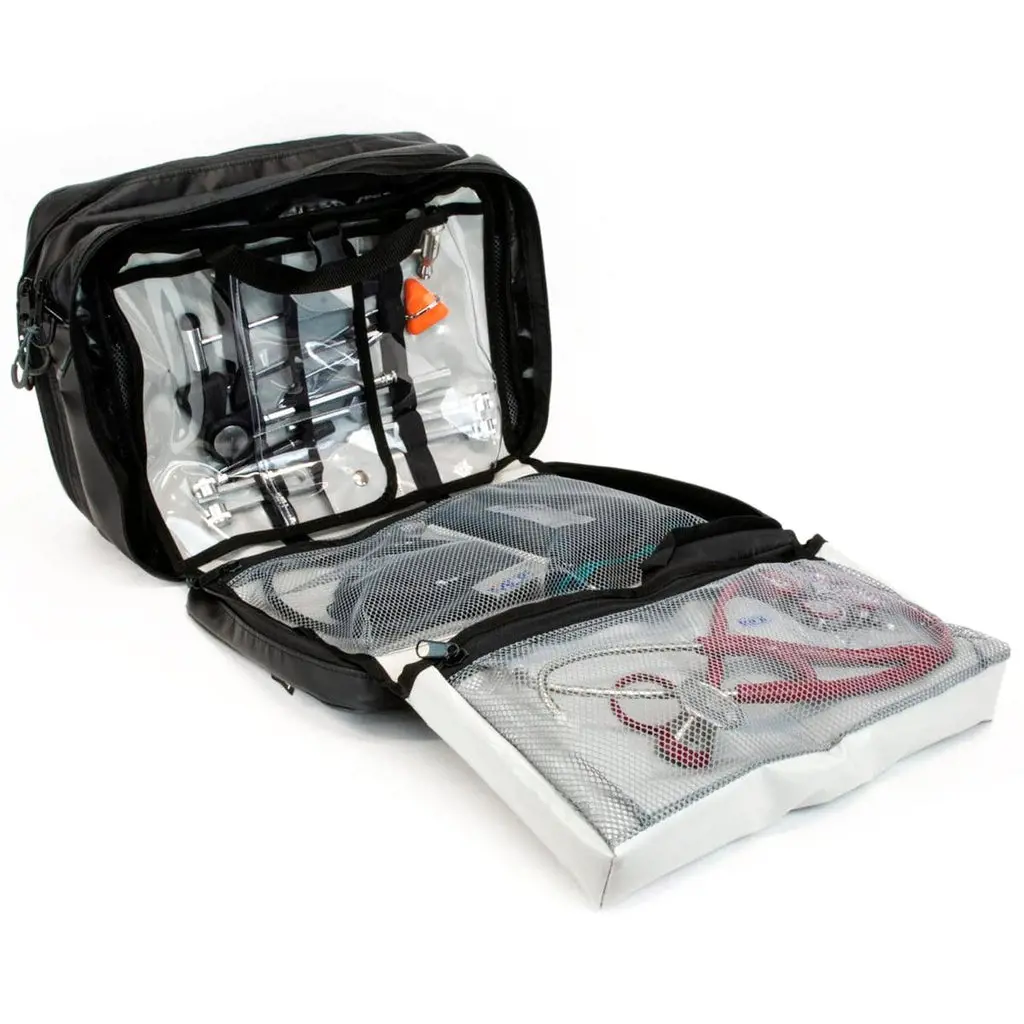
Having a go bag is essential for emergency preparedness. It is a carefully curated collection of items that can help you survive and stay comfortable during an emergency situation. However, it's important to remember that the items in your go bag are not meant to last forever. They can expire, become outdated, or simply lose their effectiveness over time. Therefore, it is crucial to update and refresh the items in your go bag regularly. Here's a step-by-step guide to help you determine how often you should do this:
- Evaluate the expiration dates: Some items in your go bag, such as food, medications, or batteries, have expiration dates. Check these dates regularly and replace any items that are about to expire. It's a good idea to set calendar reminders or make a note of when these items need to be replaced. This way, you can ensure that you always have fresh and effective supplies on hand.
- Consider environmental factors: Depending on where you live, the climate and environmental conditions can impact the lifespan of certain items in your go bag. For example, extreme temperatures can cause food and batteries to spoil faster. If you live in an area with harsh weather conditions, you may need to refresh these items more frequently. Additionally, if you've recently experienced a severe weather event or natural disaster, it's a good idea to check your go bag for any potential damage or contamination.
- Stay up to date with technology: Technology is constantly evolving, and new gadgets and tools are being developed all the time. It's important to stay informed and replace outdated items in your go bag with more advanced versions. For example, a portable solar charger or a hand-cranked radio may be more efficient and reliable than older models. Keeping up with technology can ensure that you have the most effective and efficient tools in your go bag.
- Assess personal needs and lifestyle: Everyone's go bag will vary based on their individual needs, lifestyle, and geographical location. Take the time to assess your personal situation and update your go bag accordingly. For example, if you've recently had a baby, you may need to include diapers, formula, and other essential baby items. If you've moved to a different climate, you may need to add or remove items to accommodate the new conditions. Regularly evaluating your personal needs and adjusting your go bag can help you be better prepared for any emergency situation.
- Practice and test your go bag: It's not enough to simply assemble a go bag and forget about it. Regularly practice using the items in your go bag and test their functionality. This will help you identify any items that may need to be replaced or updated. For example, you may discover that a piece of equipment is missing or malfunctioning, or that a certain item is no longer necessary. By actively using and testing your go bag, you can ensure that it remains effective and reliable.
In conclusion, updating and refreshing the items in your go bag is essential for emergency preparedness. By evaluating expiration dates, considering environmental factors, staying up to date with technology, assessing personal needs, and practicing and testing your go bag regularly, you can ensure that you are always prepared for any emergency situation that may arise. Remember, being proactive and regularly maintaining your go bag can make a world of difference when it comes to your safety and well-being.
Essential Items to Pack for Your Trip to Sri Lanka
You may want to see also
Frequently asked questions
In a go bag, it is important to include essential items that can help you in case of emergencies or unexpected situations. This includes items such as a first aid kit, extra clothing, food and water, a flashlight, batteries, a portable phone charger, and any necessary prescription medications. It is also a good idea to include important documents such as identification, insurance information, and copies of important documents. Additionally, it is recommended to include a multi-purpose tool, a whistle, cash, and any other personal items that you may need.
When packing a go bag, it is important to have enough food and water to sustain you for at least 72 hours. The general recommendation is to have one gallon of water per person per day, so for a three-day supply, you would need three gallons of water per person. In terms of food, it is best to pack non-perishable items that are easy to eat and require little to no preparation. This can include items such as granola bars, canned goods, dried fruit, and nuts. It is also a good idea to include a can opener if you are packing canned goods.
While it is not necessary to include personal items in your go bag, it can be beneficial to have certain items that provide comfort and familiarity during times of emergency. This can include items such as a spare set of glasses or contact lenses, a toothbrush and toothpaste, and any necessary personal hygiene products. Additionally, if you have any specific medical or dietary needs, it is recommended to include any necessary supplies or items in your go bag. Overall, it is important to strike a balance between including essential items and any personal items that would provide comfort or support in a difficult situation.







